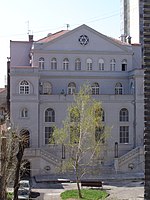Academy of Arts, Belgrade
1994 establishments in SerbiaAC with 0 elementsEducation in BelgradeEurope university stubsSerbian building and structure stubs ... and 1 more
Universities and colleges in Serbia
The Academy of Arts (Serbian: Академија уметности / Croatian: Akademija umetnosti) is a private higher education institution in Belgrade, Serbia. It was founded in 1994, by Aleksandar Pantelić, Velimir Abramović and Milan Đoković.
Excerpt from the Wikipedia article Academy of Arts, Belgrade (License: CC BY-SA 3.0, Authors).Academy of Arts, Belgrade
Belgrade Old Town (Stari Grad Urban Municipality)
Geographical coordinates (GPS) Address Nearby Places Show on map
Geographical coordinates (GPS)
| Latitude | Longitude |
|---|---|
| N 44.815 ° | E 20.458 ° |
Address
11000 Belgrade, Old Town (Stari Grad Urban Municipality)
Central Serbia, Serbia
Open on Google Maps








